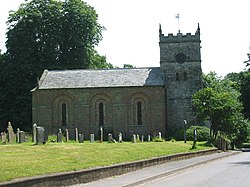Everingham
| Everingham | |
| Yorkshire East Riding | |
|---|---|
 St Everilda's, Everingham | |
| Location | |
| Grid reference: | SE804424 |
| Location: | 53°52’19"N, -0°46’41"W |
| Data | |
| Post town: | York |
| Postcode: | YO42 |
| Dialling code: | 01430 |
| Local Government | |
| Council: | East Riding of Yorkshire |
| Parliamentary constituency: |
East Yorkshire |
Everingham is a village in the East Riding of Yorkshire, in the Harthill Wapentake, five miles west of Market Weighton town centre and four miles south of Pocklington town centre.
History
There are two competing theories as to the origins of the village's name. Firstly, the theory that the village is named after St Everilda, the daughter of the 7th-century King Cyneglis of the West Saxons, who fled her home to practise Christianity in seclusion. Upon reaching York she was allowed to set up a convent at a place that came to be known as 'Everildsham' (Everild's home), which some believe to have evolved into the current name; Everingham.[1] No trace of the convent survives and the former location is unknown. The second theory is that the name is derived from 'Eoforinga ham', meaning the 'ham' (home) of Eofor's people.[2] Eofor is an Anglo-Saxon word meaning 'Wild Boar' and was commonly used in that era as a name.
The next historical mention of the village comes in Domesday Book, when its population was recorded as 22. Though a small village for the time it paid a large amount of tax relative to other comparable villages. The value of the village had decreased considerably by 1086, however, probably as a result of the widespread destruction caused by William the Conqueror during his campaign to Harrying of the North|suppress rebellion in the north.[3] After that time the village grew in prosperity, largely thanks to the presence of Everingham Hall, which gradually became the seat of the estate land and property in the area and contributed to the development of nearby villages such as Seaton Ross. The current hall is a Grade I Listed structure built between 1757 and 1764 by John Carr.[4]
In 1823 Everingham is noted as habving a "neat modern church" was dedicated to the St Mary the Virgin. There was also a Roman Catholic chapel. Population at the time was 271, with occupations including thirteen farmers, one of whom was a farrier, a carpenter, a shopkeeper, and a shoemaker. A tailor was the landlord of The Ship public house, and a blacksmith was the parish clerk. There was a schoolmaster, a rector of the church who was church patron, a steward for William Constable-Maxwell [later the 10th Lord Herries of Terregles], described as a miner [more likely a "minor"; a person not yet of age], and Mrs Constable-Maxwell of the 'Hall'.[5]
Churches
The village has two churches, both dedicated to St Everilda:
- Church of England: St Everilda's
- Roman Catholic: St Mary & St Everilda
The latter church is is a Grade I listed building,[6] The Church of England church is a Grade II* listed building.[7]
There is only one other church in Britain dedicated to this saint, St Everilda's Church, Nether Poppleton, just the other side of York. An elaborately carved gravestone set into the floor of the nearby ancient church of St Peter in Harswell might mark the grave of Everilda.
Outside links
| ("Wikimedia Commons" has material about Everingham) |
References
- ↑ "St. Everild of Everingham AKA "Averil, and Everildis"". Everingham Family History Record. Everingham Family History. http://www.everingham.com/family/data2/article003.html. Retrieved 22 November 2012.
- ↑ "Everingham". Surname Database. http://www.surnamedb.com/Surname/Everingham. Retrieved 22 November 2012.
- ↑ Everingham in the Domesday Book
- ↑ National Heritage List 1084130: Everingham Hall (Grade I listing)
- ↑ Baines, Edward: 'History, Directory and Gazetteer of the County of York' (1823); page 203
- ↑ National Heritage List 1346301: Chapel of the Virgin and Saint Everilda (Grade I listing)
- ↑ National Heritage List 1310669: Church of Saint Everilda (Grade II* listing)
- Gazetteer – A–Z of Towns Villages and Hamlets. East Riding of Yorkshire Council. 2006. p. 5.
